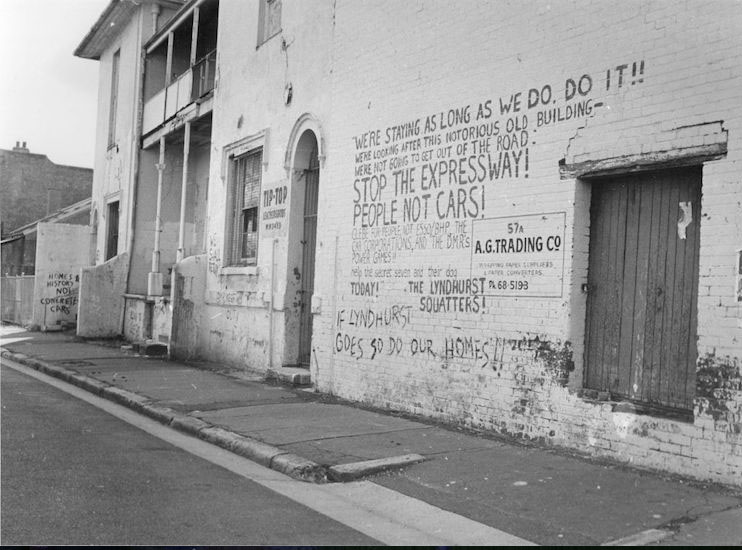Lyndhurst: The house that stopped an expressway
Lyndhurst is a symmetrical Regency, two-storey, brick garden villa originally standing on 36 acres of land. It was designed by English colonial architect John Verge for Dr James Bowman, Principal Surgeon of Sydney Hospital and the son-in-law of John Macarthur and was completed circa 1837. The house originally featured a portico of coupled Tuscan columns with the back enclosed by single-storey domestic quarters which were subsequently demolished in 1878 and 1885 upon subdivisions. Today, only the main two-storey block remains.
The Glebe Society (left to right: Prof Bernard Smith, Joye Wallace [behind], Jeanette Knox, Kate Smith, Jan Potter) protesting on Darghan Street, Glebe in 1972 against the Northwest Expressway. (Image source: Green bans, red union)
In 1972 the NSW government announced the demolition of Lyndhurst to make way for the proposewd North-Western expressway which would cut through several inner city suburbs, including Glebe. In response to these plans, the ‘Save Lyndhurst Committee’ reached out to Jack Mundey and the BLF. After a green ban was omposed on Lyndhurst in July, the Department of Main Roads began to retreat. Lyndhurst became a potent symbol for the anti-expressway movement and in 1974, residents succeeded again in preventing the Askin government from renewing the project. By 1978 the freeway plans had been largely abandoned meaning that the house, Glebe and much of the inner-city were saved.
In 1980 the Historic Houses Act (1980) established the Historic Houses Trust to provide for 'the care, control and management of certain houses of historic importance.' Lyndhurst was restored (by architect and Heritage Consultant, Clive Lucas OBE) and the building became the offices of the Historic Houses Trust for two decades. The Trust consisted of seven trustees appointed by the Governor. Dr Jack Mundey who was a Life Member of the Australian Conservation Foundation and served as the Chair of the Historic Houses Trust of NSW from 1995 to 2001. Over the years the gentrification of Glebe’s public and private housing gathered pace and remains ongoing. Lyndhurst was sold in 2006 and is now in private hands.
Meredith Burgmann, 'Valè Jack Mundey: the Builders Labourers' leader who saved Glebe', The Glebe Society, 2020; Lee Rhiannon, Green bans: inspirational activism, 2016; Anne Summers (et al.), The little green book: facts on the green bans, 1973.
Research provided by Isabella Maher and Jo Holder
Current action: Hands Off Glebe
Against overdevelopment and high-rise in Glebe. · For decent public housing in Glebe. · For preserving the historic townscape and protecting the low income community of Glebe.




